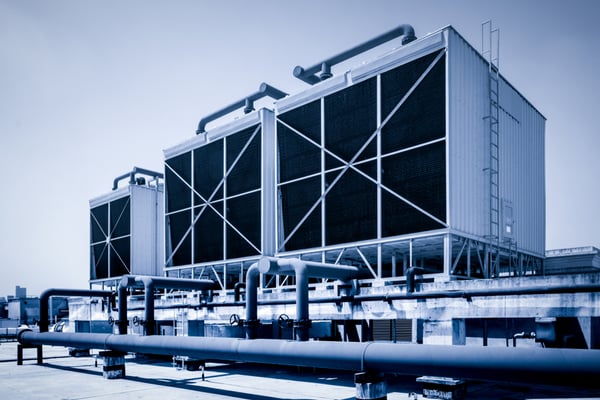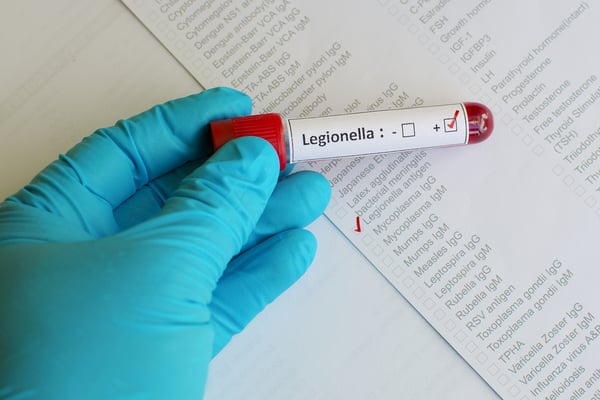How to Prevent Legionnaires’ Disease in Building Water Systems

Legionnaires’ disease is a form of pneumonia, and the disease gets its name from the Legionella bacteria that cause it. These bacteria are normally found in natural bodies of water, like rivers and lakes. However, they become dangerous when allowed to grow in man-made installations that use water.
The symptoms of Legionnaires’ disease are similar to those of a flu infection (influenza): fever, chills, muscle pain, and coughing. The range of symptoms can also include headache, fatigue, loss of appetite, confusion, and diarrhea. Compared with COVID-19, the pneumonía caused by Legionnaires’ disease is much more dangerous, with a case fatality rate of 10%.
Improve your building water quality and protect your occupants from diseases.
How Do Legionella Bacteria Grow and Spread?
Legionella bacteria thrive in warm water at temperatures between 68°F and 122°F, especially if the water is stagnant or slow-moving. According to the US Department of Health and Human Services, Legionella bacteria often grow on the following components of building water systems:
- Storage tanks and expansion tanks
- Water heaters
- Water hammer arrestors
- Water filters
- Faucets, both manual and electronic
- Aerators and flow restrictors
- Showerheads and hoses
- Pipes, valves, and fittings
- Atomizers, air washers, and humidifiers
- Ice machines
- Hot tubs
- Fountains
- Cooling towers
- Medical devices
- In general, equipment that is not used frequently
Legionnaires’ disease is acquired by inhaling water droplets contaminated with Legionella. The disease cannot be acquired from drinking contaminated water unless it reaches the lungs accidentally while swallowing. Also, the disease cannot spread between humans - being close to an infected person does not pose a risk.
Even when Legionnaires’ disease cannot be transmitted between persons, building owners should act quickly if a case is reported on their property. The presence of Legionella bacteria is a clear warning sign that water systems in a building need attention.

Individuals who meet any of the following conditions are at a greater risk of getting Legionnaires’ disease:
- Age 50 or above
- Smokers
- Chronic lung disease patients
- Persons with a weakened immune system
- Persons taking medication that weakens the immune system
How Common Is Legionnaires’ Disease in NYC?
The latest Legionnaires’ disease report from the NYC Department of Health & Mental Hygiene is for 2017. There were 435 reported cases that year, and there are typically between 200 and 500 cases annually. The number of cases may seem small in a city with a population of over 8.6 million, but the rate of Legionnaires’ disease cases has been increasing by 8.1% annually between 2010 and 2017.
- The 2015 outbreaks of Legionnaires’ disease were the most severe in recent years. They affected 133 persons, mostly in the Bronx, and there were 16 casualties. Many of the cases in 2015 were caused by poorly-serviced cooling towers.
- More recently in 2018, an outbreak in Washington Heights infected 27 persons and caused one casualty.
- In July 2019, there were two simultaneous cases of Legionnaires’ disease at Manhattan Plaza.
Legionnaires’ disease can be treated effectively with antibiotics, especially if the patient gets quick attention. However, the disease can have severe complications if left unattended: the case fatality rate is around 10%, and patients with preexisting health conditions are at higher risk. Hospital-acquired infections are even more dangerous, with a fatality rate of 25%.
What Do Codes & Standards Say About Legionella?

Given the importance of keeping Legionella under control in building water systems, ASHRAE created Standard 188, which is called Legionellosis: Risk Management for Building Water Systems. The first version was published in 2015, and an updated version was published in 2018.
ASHRAE Standard 188 specifies the building types and system components that need a water management program, and also the minimum requirements for such a program. ASHRAE standards by themselves are not mandatory, but they provide a key reference for building codes at the state and city level.
In New York City, Local Law 77 of 2015 requires all cooling towers to be registered with the Department of Buildings. Each year, cooling tower owners must certify that the units have been inspected, tested, cleaned and disinfected. Cooling towers must also be registered with the NYS Department of Health.
The NYC Administrative Code provides detailed requirements for cooling towers based on ASHRAE Standard 188, covering the following aspects:
- Maintenance program and records
- Process control measures
- Automated water treatment
- System shutdown and startup
- Commissioning new cooling towers
Currently, NYC codes only address Legionella in cooling towers. However, several design measures can be deployed to control these bacteria in other water systems:
- Storing hot water at 140°F is one of the most effective ways to deal with Legionella since that temperature is too hot for the bacteria. 140°F is also a dangerous water temperature for humans, but this is solved by mixing cold water before it reaches a plumbing fixture.
- Ultraviolet disinfection systems can also kill Legionella. UV radiation is more effective when the water content of sediment and scale has been reduced first. This can be accomplished with filtration and anti-scale systems.
- Dead legs in plumbing systems should be avoided at all costs. They are commonly found in plumbing installations that have been modified, leaving pipe runs that lead nowhere. Legionella can easily grow in the stagnant water trapped in dead legs.
- When tankless water heaters are used, recirculation systems can help prevent Legionella. In addition, they reduce the time needed for hot water to reach fixtures, conserving water.
Responding to Cases of Legionnaires’ Disease

If a building occupant is infected by Legionella, the owner is legally required to report the case to the NYC Department of Health & Mental Hygiene. The same applies if Legionella bacteria are detected in a building system, even if nobody has been infected yet.
The Department will then visit the affected building to perform a detailed investigation. They will work with the building staff to develop a Legionella sampling plan, in order to test all water systems in the facility.
A Legionella remediation plan is developed based on the testing results, and the building owner must implement the plan within the timeframe specified by the department. This includes a short-term remediation plan, which must be implemented within 96 hours.
Conclusion
To prevent Legionella growth and protect building occupants, the best solution is to have well-designed hydronic and plumbing installations. The design should prevent areas where warm water can accumulate since that creates an ideal environment for Legionella.
If you are planning a major renovation, consider a professional assessment of your plumbing installation. This way, you can identify potential measures to conserve water, which also saves energy on pumping and heating. Parts of the installation that are susceptible to Legionella growth can be identified and fixed.

Ankit Javeri
Ankit is the Project Manager at NY Engineers, who holds an M.Tech. Some of his projects includes Community Access, Jackson Avenue
Join 15,000+ Fellow Architects and Contractors
Get expert engineering tips straight to your inbox. Subscribe to the NY Engineers Blog below.

